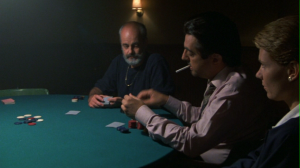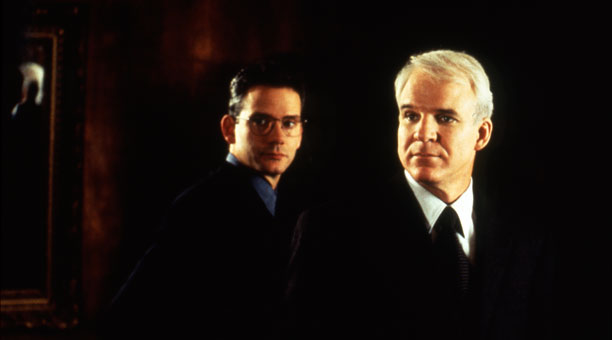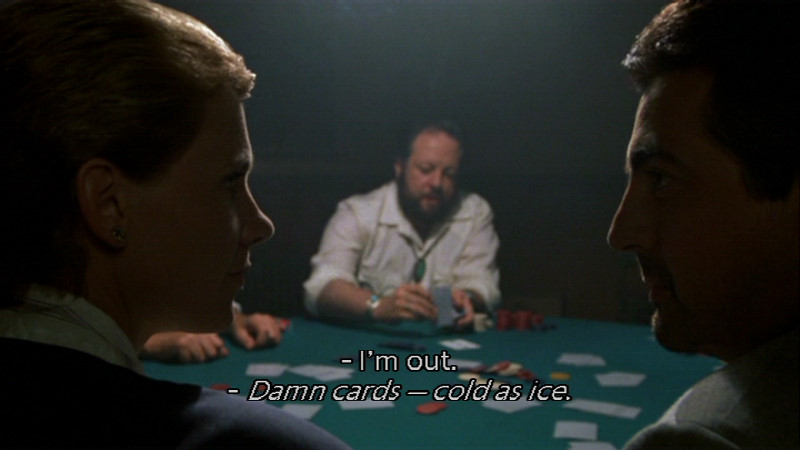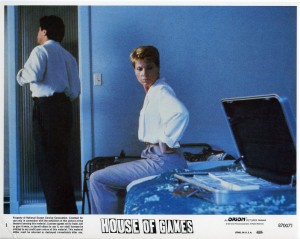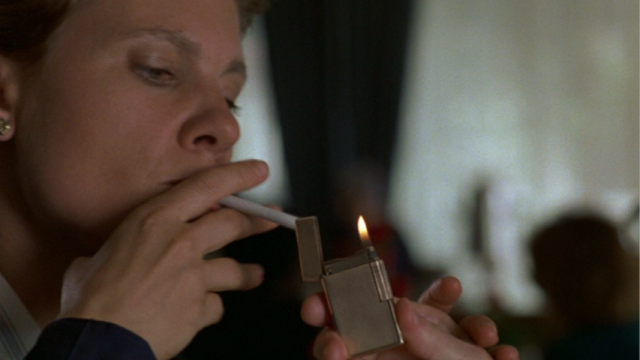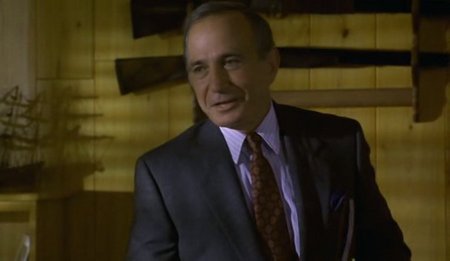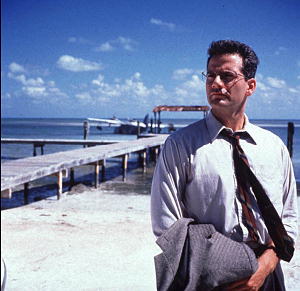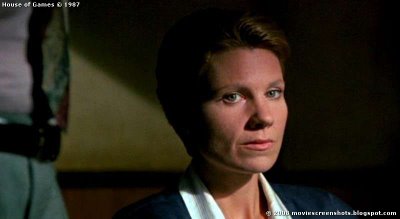From Scenario, Vol. 4, No. 1, Spring 1998. –- J.R.
“Hitchcock lives!” I was inspired to write at the head of my review of House of Games, David Mamet’s first feature, in 1987. Ten years later, Mamet’s fifth feature, The Spanish Prisoner, boasts plenty of Hitchcockian elements of its own. But this time I’m not as prone to employ the same assertion.
The difference has less to do with Hitchcockian influence than with the use of that influence — the issue of whether Mamet is borrowing something substantive from the Master of Suspense, or drawing upon Hitchcock only when it suits his strategies. But one of the salient differences I find between reading the script of The Spanish Prisoner and seeing it realized is the difference between finding a Hitchcockian thriller on the page and not quite seeing one on the screen. Both are clearly Mamet creations, but the first comes closer to showing Hitchcock’s special qualities in tandem with Mamet’s, whereas the second shows them shooting off in separate directions.
Put somewhat differently, the distinction has a lot to do with issues that seem central to any evaluation of Hitchcock as well as Mamet -– namely, the ethics and aesthetics of deception, which are intimately tied to the ethics and aesthetics of representing a real world where deception becomes possible. It’s interesting to speculate, for instance, on why there are many more Japanese tourists in the script of The Spanish Prisoner than in the film itself. In both script and film. Mamet is interested in saying something about the operations of multinational business, the fantasy of controlling global money markets — a subject that is relatively abstract in movie terms. Japanese tourists, who serve many different kinds of evocative and deceptive functions over the course of the story represent one possible way of making that subject seem less abstract, usually through their appearances as “local color” in various locations — faint but distinct reminders of the forces at play in multinational intrigues. Yet when it came to putting them on the screen, Mamet chose to make them less prominent — perhaps because he felt that they detracted attention from his dialogue, the principal medium of his deceptions. Hitchcock, who tends to depend more often on images for his own deceptions, probably would have left them all in.
Although Mamet has also followed the example of Hitchcock in developing an artificial, jokey persona to mask the more personal side of his work — macho and cryptic in his case, macabre and droll in Hitchcock’s — it should be emphasized at the outset that the relation of each artist to filmmaking is profoundly different. Hitchcock was first and last a man of the cinema, and every item in his bag of tricks was a resource intended to protect or develop that identity. Mamet is first and last a man of the theater, which ultimately means that cinema for him is something that he usually practices with his left hand — whether this entails light entertainments as a screenwriter on certain projects or more serious application of his gifts to a medium that, even then, he regards as less important.
Where the filmic practice of these two artists differs most sharply is less in their taste for fantasy than in the evocation of a sense of normality and the real world that makes that fantasy possible. The conventions for establishing everyday reality in film and on the stage are radically different in terms of time as well as space –- a fact that becomes readily apparent if one examines Hitchcock’s process of adapting plays in such movies as Rope and Dial ”M” for Murder. Performing for a live audience within a shared space and shared block of time entails a different kind of social contract from the more scattered and piecemeal practices of filmmaking, involving different kinds of illusion as well as reality. Thus when Mike (Joe Mantegna) whispers secret questions and instructions to Margaret Ford (Lindsay Crouse) at a pivotal poker game early in House of Games, asking her to observe the gestures of another player (Ricky Jay) to tell whether he’s bluffing about his hand, the physical proximity of the Mike and Margaret characters to the other players in the room threatens credibility — something that wouldn’t happen in the same fashion if the situation were taking place on a stage, where we’d find it easier to accept the premise of a private conversation within a confined space without wondering why the other players don’t seem to notice. If we accept the premise that the other poker players don’t perceive what’s going on, this is most likely because we agree to accept the stage conventions that are Mamet’s stock-in-trade rather than accept the location as a film set.
Similarly, when, much later in the film, Mike, a professional con artist, takes Margaret, a professional psychologist, along on an elaborate scam involving one of Mike’s colleagues (Mike Nussbaum), a planted suitcase full of money, and a supposedly innocent bystander (J.T. Walsh), the four characters wind up in the bystander’s hotel room at night, arguing about what to do with the money. After a fade-out, we find the same four characters in the same hotel room at 8:30 the following morning — an ellipsis that arguably carries a different kind of weight in a film and in a play by being indicated quite differently. If the same scene were unfolding on a stage, the ellipsis would probably be handled with a momentary blackout or the curtain falling, and how the audience would piece together the missing hours would differ somewhat as a result. Here again, I suspect that Mamet’s instinctive reliance or stage conventions creates a momentary suspension of belief — a small hole in the narrative that wouldn’t be noticed as much if House of Games were a play.
Although I’ve focused here on two minor flaws in House of Games that I think are derived from Mamet’s failure to adapt his stage instincts to movie terms, I don’t mean to suggest by this that House of Games is in any respect a failure. On the contrary, it’s a stunning first feature, and one that adapts certain principles from Hitchcock in a masterly fashion. Charting the means by which a repressed woman is enticed into a man’s life of crime through an elaborate con game that relies on her secret urges — a process she ultimately views as therapeutic once she succeeds in forgiving herself for her gullibility and in exacting revenge — it also comprises a critique of spectatorship by luring the viewer who follows Margaret Ford’s quest into a comparable series of self-deceptions. In this respect, it combines the Hitchcockian theme of voyeurism as played out in Rear Window and Vertigo with the no less Hitchcockian theme of therapeutic self-discovery as exemplified by thrillers as diverse as Rear Window and Marnie.
The author of a celebrated book called Driven: Compulsion and Obsession in Everyday Life, Margaret Ford is a study in disavowal, someone who tells herself that her interest in confidence tricks is strictly professional — much as James Stewart’s apartment-bound photographer in Rear Window supposedly spies on his neighbors just out of idle curiosity, and his convalescing detective in Vertigo agrees to tail a man’s obsessed wife (Kim Novak) simply as a favor. Ford turns up at the aforementioned poker game because one of her young patients. a compulsive gambler named Billy, brandishing a gun and threatening suicide, tells her of a $25,000 gambling debt he is unable to pay.She gets him to hand over the gun and later decides to see Billy’s debtor, Mike, to ask him to let up on the boy, which leads her to the House of Games. Before she leaves her office, she comes across Billy’s gun — a moment described in the script as follows:
Interior: Ford’s Office — Later — Night
AngIe. Ford, alone at her desk, with a cup
of coffee. Smoking. Writing (pause), she
sighs, looks up, takes off her glasses.
Shakes her head. from side to side. She
picks up off her deskBilly’s nickled
automatic pistol.
Angle — Insert. The pistol in her hand. She
lays it on the desk. Camera follows her
hands. She picks up a sheaf of notes,
shuffles through the notes. Brings up a
sheet from the botton. On it is written:
“…The character of Mike — the ‘Unbeatable
Gambler.’ Seen as omniscient, who ‘doles
out punishment’…HOUSE OF GAMES.” (1)
Significantly. Mamet’s realization of this pivotal moment as a director demonstrates that he’s an apt pupil of Hitchcock. especially when it comes to fashioning a logic of continuity in Ford’s gestures and what they imply. In the film, where she’s already established as a chain smoker, she comes upon Billy’s pistol inside her desk drawer while she’s looking for matches to light a cigarette; after briefly fingering the piece, she returns it to the desk drawer, which she closes. It’s a small alteration, but a psychologically revealing one, because a token of one of her own compulsions (smoking) leads her to a token of Billy’s gambling compulsion (the gun); and the fact that she then returns the pistol to its hiding place suggests repression as well as compulsion. This is precisely the sort of gestural notation that Hitchcock excelled in, and Mamet’s use of it to clarify her motivations is as letter-perfect as her casual, post-therapeutic stealing of another woman’s lighter in the movie’s final sequence, which evokes Marnie.
Reinterpreting data is what a psychologist like Ford does for a living, and it’s also what the heroes and spectators are kept busy with throughout House of Games, Rear Window, Vertigo, and Marnie -– not to mention The Spanish Prisoner, The 39 Steps, and North by Northwest, to propose another homogeneous Mamet-Hitchcock cluster. The second cluster might be termed Mamet-Hitchcock Lite in comparison with the first — a trio of jaunty chase comedies without the same brooding psychological undercurrents — and if Mamet proves less of a match for Hitchcock on this more picaresque and rambling terrain, part of the reason may be that he doesn’t want to be. Another reason is that he adheres more closely to Hitchcock’s theory than he does to his practice.
I’m thinking in particular about Hitchcock’s theory of the “MacGuffin” — expounded on at some length in his celebrated book-length interview with François Truffaut, with specific reference to the chase thrillers cited above. For Hitchcock, the MacGuffin is “the device, the gimmick, if you will, or the papers the spies are after”:
Most of Kipling’s stories, as you know, were set in India,
and they dealt with the fighting between the natives and the
British forces on the Afghanistan border.Many of them were
spy stories, and they were concerned with the efforts to steal
the secret plans out of a fortress. The theft of secrtet documents
was the original MacGuffin: So the “MacGuffifn” is the term we
use to cover all that sort of thing: to steal plans or documents,
or discover a secret, it doesn’t matter what it is. And the
logicians are wrong in trying to figure out the truth of a
MacGuffin, since it’s beside the point. The only thing that
really matters is that in the picture the plans, documents, or
secrets must seem to be of vital importance to the characters.
To me, the narrator, they’re of no importance whatever. (2)
In The 39 Steps, the MacGuffin is the formula for the construction of an airplane engine; in North by Northwest, which in many ways is a distillation of Hitchcock’s previous chase films, it’s simply “government secrets.” In The Spanish Prisoner, it’s something known as “The Process” — a profitable business strategy developed by the hero, Joe Ross (Campbell Scott), for a company based in New York, whose essence is contained in a mathematical formula. At the beginning of the picture, Ross presents this invention to his boss (Ben Gazzara), a colleague (Ricky Jay), and a few businessmen at a cloistered board meeting in St. Estephe. There, he and a company secretary, Susan Ricci (Rebecca Pidgeon), cross paths with a mysterious tycoon named Jimmy Dell (Steve Martin), who asks him to deliver a book to his sister in New York — launching Ross into a series of predicaments and deceptions during which The Process is stolen and pursued and eventually winds up in the final resting ground of all secrets in today’s surveillance culture — as a mass-produced CD-ROM.
The fact that we never know what The Process is functions as a self-reflexive joke that wouldn’t be out of place in a novel like Henry James’ The Ambassadors (which is similarly reticent about the object manufactured by its hero’s company), but at least on the screen, it interferes with the usual operations of a Hitchcockian chase thril1er. Like Hitchcock’s theoretical MacGuffin, The Process matters a great deal to the movie’s characters and not at all to the film’s author. Yet unlike Hitchcock’s practical use of the MacGuffin, which cons the audience, Mamet’s withholding of what The Process actually is reduces the audience’s own investment in the proceedings, perhaps because Mamet is after something else. Identification with the hero -– crucial in House of Games, Rear Window, Vertigo, and all the Hitchcock chase movies — becomes disrupted if it’s established at the outset that the hero knows something we don’t. The audience of North by Northwest may not care much about the MacGuffin once it’s finally unveiled; but prior to that unveiling, when Cary Grant is undergoing a series of bewildering mishaps and trying to understand his predicament, it’s pretty difficult not to care. So the logic of continuity that allowed Mamet to create Ford’s attraction/ repulsion toward the world of crime -– an ambivalence shared by the audience — comes across as relatively unimportant in The Spanish Prisoner when it’s built around an empty signifier that declares itself as such; the stakes are automatically lowered.
On the other hand, Mamet’s interest in male gamesmanship and competition is a far cry from Hitchcock’s usual turf, and keeping the spectator less invested in the plot and characters might make it easier for certain points lo be made about the exploitation of creative individuals within multinational game plans. (lf The Process functions in The Spanish Prisoner as the ultimate player’s tool, spelling out what it is only confuses the issue. From this standpoint, the fact that Joe Ross is something of a Boy Scout, as Susan observes in the opening scene — more asexual than Robert Donat in The 39 Steps and Cary Grant in North by Northwest, but less androgynous than Margaret Ford in House of Games — surely counts for more than the precise nature of what he’s invented for his company.)
The relatively pared-down settings of House of Games allow Mamet to convince us that the world he’s presenting us is complete and fully realized. In The Spanish Prisoner, by contrast, where we’re shunted from the Caribbean to New York and then off to Boston, between characters purporting to be millionaires and characters purporting to be FBI agents, in transport ranging from airplanes to cars and shuttle boats, and locales ranging from palatial resort suites to Central Park and police headquarters, the task of establishing a recognizable and homogeneous world, which Hitchcock is so adept at, is only cursorily attended to. As often happens in Mamet’s work, the words conjure up a mannerist universe where everyone talks the same way while the images seem more borrowed than invented. (Consider the offices and apartments of both Ford and Ross, defined mainly by their neutrality, or the fact that both heroes arrive at key moments of self-recognition in the public, impersonal spaces of airports.)
None of this matters if the words do enough of the job by themselves, which happens more readily when we read the screenplay. As an exercise in deception and subterfuge, complete with an earnest hero and Janus-faced Girl Friday, The Spanish Prisoner is diverting and absorbing, even when it makes room for dark suggestions about mutable natures and untrustworthy loyalties. But it wouldn’t be accurate to say that “Hitchcock lives” in the case of this film. Both House of Games and The Spanish Prisoner offer moments of horrified reckoning when Margaret Ford and Joe Ross, innocent victims of other people’s machinations, find themselves literally with blood on their hands. In the first case, though the blood belongs to Ford herself, it’s a dramatic turning point, leading her inexorably to the point where she’s ready to shed someone else’s blood. In the second case, the blood belongs to Ross’s best friend, and this death is one more link in a vast impersonal chain that illustrates the chilling notion of multinational interests as inscrutable and unstoppable.
End Notes
- Mamet, David, House of Games, NY: Grove Press, 1987, p. 11.
- Truffaut/Hitchcock, NY: Simon and Schuster, 1967, p. 99.

